An RFID-Based Sensor for Masonry Crack Monitoring
Abstract
:1. Introduction
2. System Description
2.1. Reader Description
2.2. Tag Description
3. Experimental Assessment
4. Conclusions
Funding
Conflicts of Interest
References
- Robert, A. Dielectric permittivity of concrete between 50 MHz and 1GHz and GPR measurements for building material evaluation. J. Appl. Geophys. 1998, 40, 89–94. [Google Scholar] [CrossRef]
- Villain, G.; Derobert, X.; Sbartai, Z.M.; Balayssac, J.P. Evaluation of concrete water content and other durability indicators by electromagnetic measuremens. In Proceedings of the 13th Conference of Ground Penetrating Radar (GPR), Lecce, Italy, 21–25 June 2010. [Google Scholar]
- Favro, L.D. Thermosonic imaging for NDE. In Review of Progress in Quantitative Nondestructive Evaluation; Thompson, D.O., Chimenti, D.E., Eds.; American Institute of Physics: Washington, DC, USA, 2001; Volume 20 A, pp. 478–482. [Google Scholar]
- Capdevila, S.; Jofre, L.; Romeu, J.; Bolomey, J.C. Water infiltration detection in civil engineering structures using RFID. In Proceedings of the 6th European conference on antennas and Propagation EUCAOP2011, Rome, Italy, 11–15 April 2011. [Google Scholar]
- King, R.J.; Stiles, P. Microwave nondestructive evaluation of composites. In Review of Progress in Quantitative Nondestructive Evaluation; Plenum: New York, NY, USA, 1984; Volume 3, pp. 1073–1081. [Google Scholar]
- Bolomey, J.C. Microwave imaging techniques for NDT and NDE. In Proceedings of the Training Workshop on Advanced Microwave NDT/NDE Techniques Supelec/CNRS, Paris, Italy, 7–9 September 1999. [Google Scholar]
- Tabib-Azar, M. Applications of an ultra high resolution evanescent microwave imaging probe in the nondestructive testing of materials. Mater. Eval. 2001, 59, 70–78. [Google Scholar]
- Caorsi, S.; Massa, A.; Pastorino, M.; Donelli, M. Improved microwave imaging procedure for non-destructive evaluations of two-dimensional structures. IEEE Trans. Antennas Propag. 2004, 52, 1386–1397. [Google Scholar] [CrossRef]
- Benedetti, M.; Donelli, M.; Franceschini, G.; Pastorino, M.; Massa, A. Effective Exploitation of the A Priori Information through a microwave imaging procedure based on the SMW for NDE/NDT applications. IEEE Trans. Geosci. Remote Sens. 2005, 43, 2584–2592. [Google Scholar] [CrossRef]
- Benedetti, M.; Donelli, M.; Martini, A.; Pastorino, M.; Rosani, A.; Massa, A. An Innovative Microwave-Imaging Technique for Nondestructive Evaluation: Applications to Civil Structures Monitoring and Biological Bodies Inspection. IEEE Trans. Instrum. Meas. 2006, 55, 1878–1884. [Google Scholar] [CrossRef] [Green Version]
- Benedetti, M.; Donelli, M.; Lesselier, D.; Massa, A. A two-step inverse scattering procedure for the qualitative imaging of homogeneous cracks in known host media—Preliminary results. IEEE Antennas Wirel. Propag. Lett. 2007, 6, 623–626. [Google Scholar] [CrossRef]
- Finkenzeller, K. RFID Handbook, 2nd ed.; Wiley: New York, NY, USA, 2004. [Google Scholar]
- Dobkin, D.M. The RF in RFID: Passive UHF RFID in Practice; Elsevier: New York, NY, USA, 2006. [Google Scholar]
- Capdevila, S.; Jofre, L.; Romeu, J.; Bolomey, J.C. Passive RFID based sensing. In Proceedings of the IEEE International Conference on RFID-Technologies and Applications, Orlando, FL, USA, 12–14 April 2011. [Google Scholar]
- Curty, J.P.; Joehl, N.; Dehollain, C.; Declercq, M.J. Remotely powered addressable UHF RFID integrated system. IEEE J. Solid-State Circuits 2005, 40, 2193–2201. [Google Scholar] [CrossRef]
- Girbau, D.; Ramos, A.; Lazaro, A.; Rima, S.; Villarino, R. Passive wireless temperature sensor based on time-coded UWB chipless RFID tags. IEEE Trans. Microw. Theory Tech. 2012, 60, 1–10. [Google Scholar] [CrossRef]
- Rennane, A.; Abdelnour, A.; Kaddour, D.; Touhami, R.; Tedjini, S. Design of passive UHF RFID sensor on flexible foil for sports balls pressure monitoring. ET Microw. Antennas Propag. 2018, 12, 2154–2160. [Google Scholar] [CrossRef]
- Jin Baek, J.J.; Kim, S.W.; Park, K.H.; Jeong, M.J.; Kim, Y.T. Design and Performance Evaluation of 13.56-MHz Passive RFID for E-Skin Sensor Application. IEEE Microw. Wirel. Components Lett. 2018, 28, 1074–1076. [Google Scholar] [CrossRef]
- Preradovic, S.; Menicanin, A. Chipless wireless sensor node. In Proceedings of the MIPRO, Opatija, Croatia, 21–25 May 2012; pp. 179–182. [Google Scholar]
- Donelli, M. Design of long-range, powerless RFID sensor at 10 GHz. Electron. Lett. 2013, 49, 1277–1278. [Google Scholar] [CrossRef]
- Donelli, M. A chipless RFID system based on substrate impedance waveguide resonators (SIW). In Proceedings of the 2017 IEEE-APS Topical Conference on Antennas and Propagation in Wireless Communications (APWC), Verona, Italy, 10–15 September 2017. [Google Scholar]
- Cherrojo, R.; Mata-Contreras, J.; Núñez, A.; Paredes, F.; Ramon, E.; Martín, F. Near-Field Chipless-RFID System With High Data Capacity for Security and Authentication Applications. IEEE Trans. Microw. Theory Tech. 2017, 65, 5298–5308. [Google Scholar] [CrossRef] [Green Version]
- Garbati, M.; Perret, E.; Siragusa, R.; Halopè, C. Toward Chipless RFID Reading Systems Independent of Tag Orientation. IEEE Microw. Wirel. Compon. Lett. 2017, 27, 1158–1160. [Google Scholar] [CrossRef]
- Bolomey, J.C.; Gardiol, G. Engineering Applications of the Modulated Scattering Technique; House, A., Ed.; Arthec House: London, UK, 2001. [Google Scholar]
- Donelli, M. Guidelines for the design and optimization of wireless sensors based on the modulated scattering techniques. IEEE Trans. Instrum. Meas. 2014, 63, 1824–1833. [Google Scholar] [CrossRef]
- Bracht, R.; Miller, E.K.; Kuckertz, T. Using an impedance-modulated reflector for passive communication. In Proceedings of the IEEE Antennas Propagation International Symposium, Montreal, QC, Canada, 13–18 July 1997; pp. 1070–1073. [Google Scholar]
- Bracht, R.; Miller, E.K.; Kuckertz, T. An impedance modulated reflector system. IEEE Potentials 1999, 18, 29–33. [Google Scholar] [CrossRef]
- Donelli, M.; Viani, F. Remote inspection of the structural integrity of engineering structures and materials with passive MST probes. IEEE Trans. Geosci. Remote Sens. 2017, 55, 12. [Google Scholar] [CrossRef]
- Donelli, M. A 24 GHz environmental sensor based on the modulated scattering technique (MST). In Proceedings of the IEEE Conference on Antenna Measurements and Applications CAMA 2014, Juan Les Pens, France, 16–19 November 2014. [Google Scholar]
- Donelli, M.; Manekiya, M. Development of Environmental Long Range RFID sensors based on the modulated scattering technique. Electronic 2018, 7, 106. [Google Scholar] [CrossRef]
- Donelli, M.; Franceschini, D. Experiments with a modulated scattering system for through-wall identification. IEEE Antennas Wirel. Propag. Lett. 2010, 9, 20–23. [Google Scholar] [CrossRef]
- Tehran, H.M.; Laurin, J.; Kashyap, R. Optically modulated probe for precision near-field measurements. IEEE Trans. Instrum. Meas. 2010, 59, 2755–2762. [Google Scholar] [CrossRef]
- Donelli, M.; Pastorino, M.; Caorsi, S. A passive antenna system for data acquisition in scattering applications. IEEE Antennas Wirel. Propag. Lett. 2001, 1, 203–206. [Google Scholar]
- Ostradahimi, M.; Mojabi, P.; Noghanian, S.; Shafai, L.; Pistorius, S.; Lovetri, J. A novel tomography system based on the scattering probe technique. IEEE Trans. Instrum. Meas. 2012, 62, 379–390. [Google Scholar] [CrossRef]
- Choi, J.H.; Moon, J.I.; Park, S.O. Measurement of the modulated scattering microwave fields using dual-phase lock-in amplifier. IEEE Antennas Wirel. Propag. Lett. 2004, 3, 340–343. [Google Scholar] [CrossRef]
- Liang, W.; Hygate, G.; Nye, J.F.; Gentle, D.G.; Cook, R.J. A probe for making near-field measurements with minimal disturbance: The optically modulated scatterer. IEEE Trans. Antennas Propag. 1997, 1, 772–780. [Google Scholar] [CrossRef]
- Bolomey, J.C.; Capdevila, S.; Jofre, L.; Tedjini, S. Sensitivity analysis for wireless dielectric reflectometry with modulated scatterers. In Proceedings of the 15th URSI General Assembly and Scientific Symposium, Istanbul, Turkey, 13–20 August 2011; pp. 1–4. [Google Scholar]
- Donelli, M. A broadband modulated scattering technique (MST) probe based on a self-complementary antenna. In Proceedings of the 2017 IEEE-APS Topical Conference on Antennas and Propagation in Wireless Communications (APWC), Verona, Italy, 10–15 September 2017. [Google Scholar]
- Donelli, M.; Viani, F. Graphene based antenna for the design of modulated scattering technique (MST) wireless sensors. IEEE Antennas Wirel. Propag. Lett. 2016, 15, 1561–1564. [Google Scholar] [CrossRef]
- Skolnik, M.I. Radar Handbook; McGraw-Hill: New York, NY, USA, 1990. [Google Scholar]
- Harrington, R. Electromagnetic scattering by antennas. IEEE Trans. Antennas Propag. 1963, 5, 595–596. [Google Scholar] [CrossRef]
- Vernon, F. Application of the microwave homodyne. IEEE Trans. Antennas Propag. 1952, PGAP-4, 110–116. [Google Scholar] [CrossRef]
- King, R.J. Microwave Homodyne Systems; P. Peregrinus on behalf of the Institution of Electrical Engineers: London, UK, 1978. [Google Scholar]
- Horowitz, P. The Art of Electronics; Cambridge University Press: Cambridge, UK, 1989. [Google Scholar]

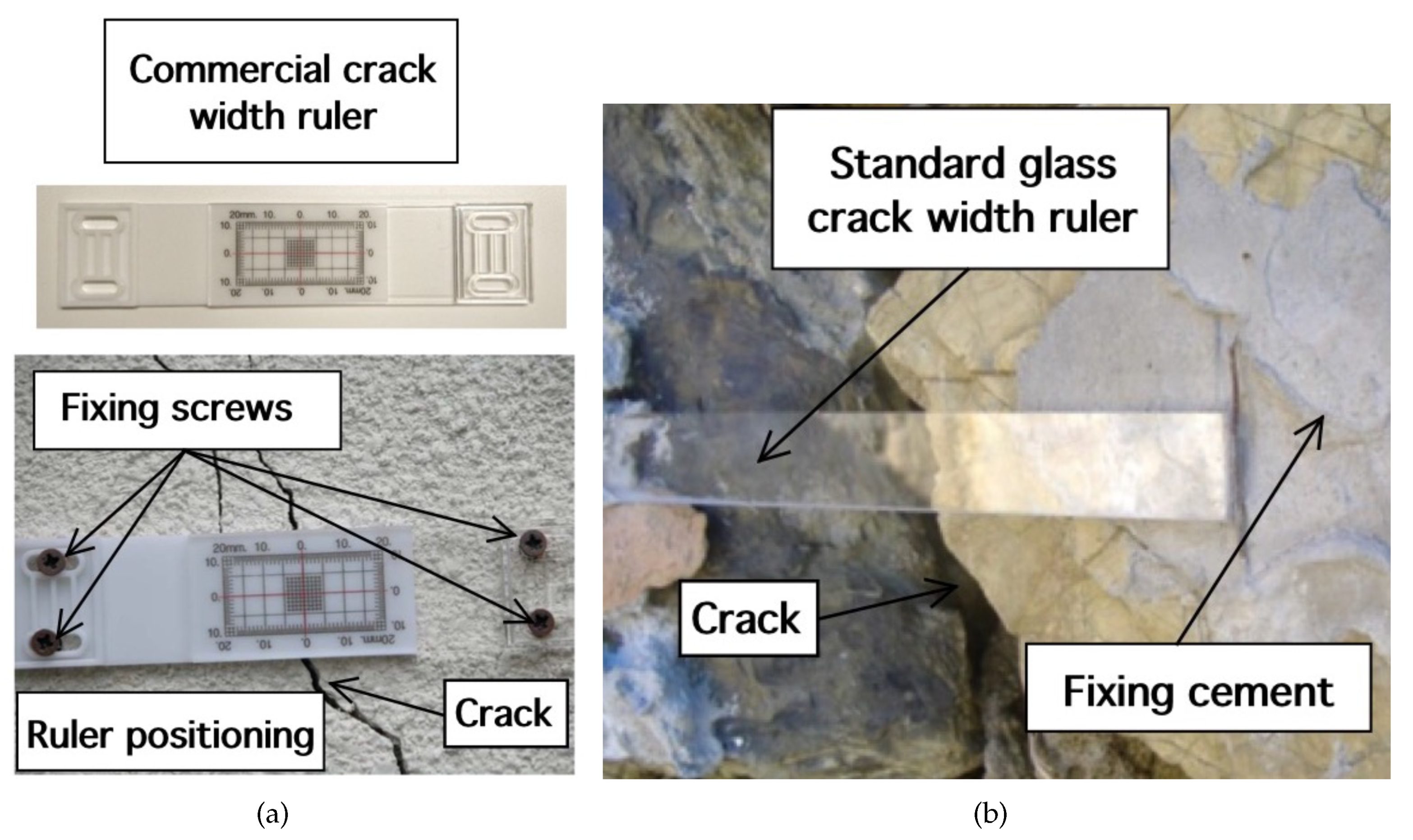
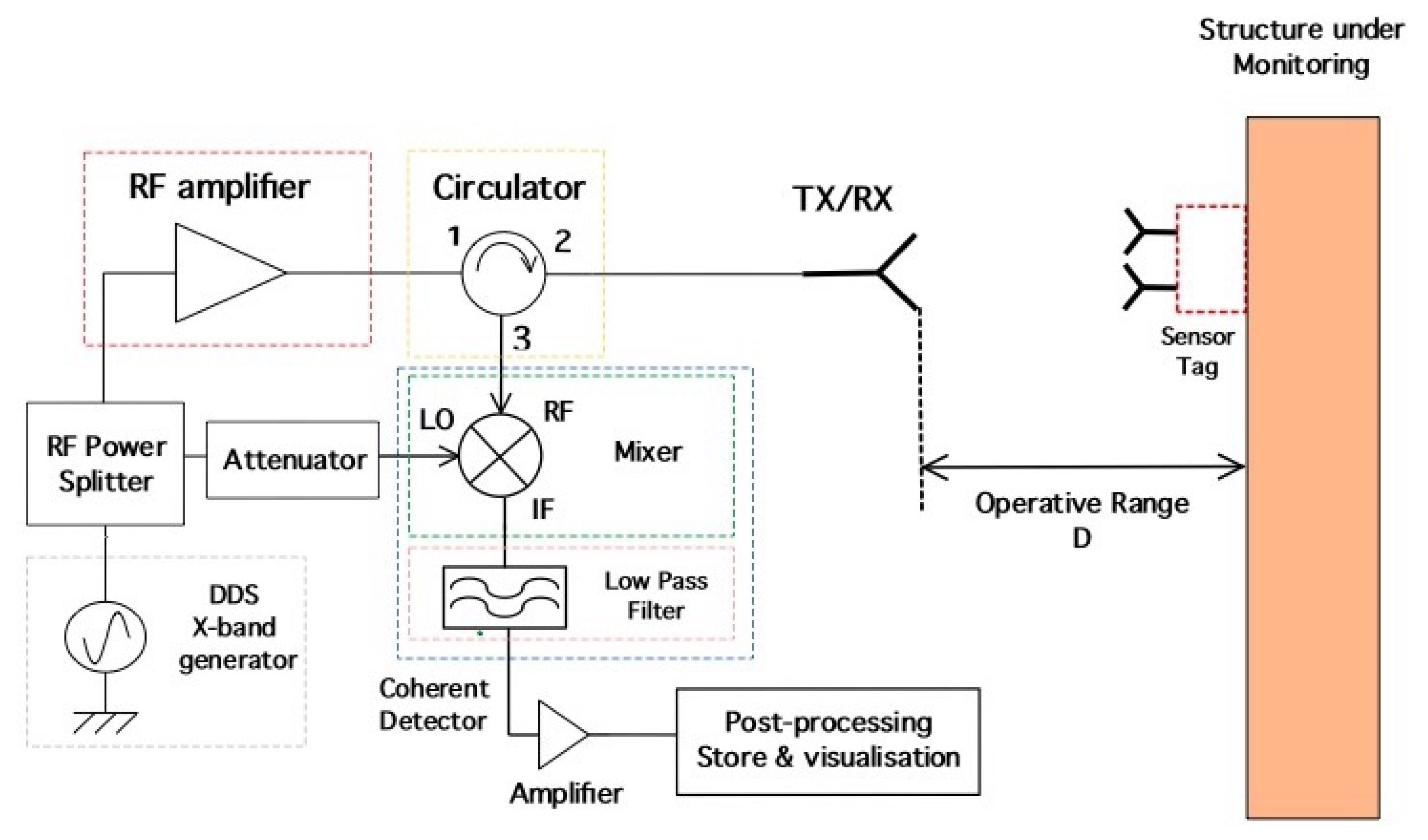

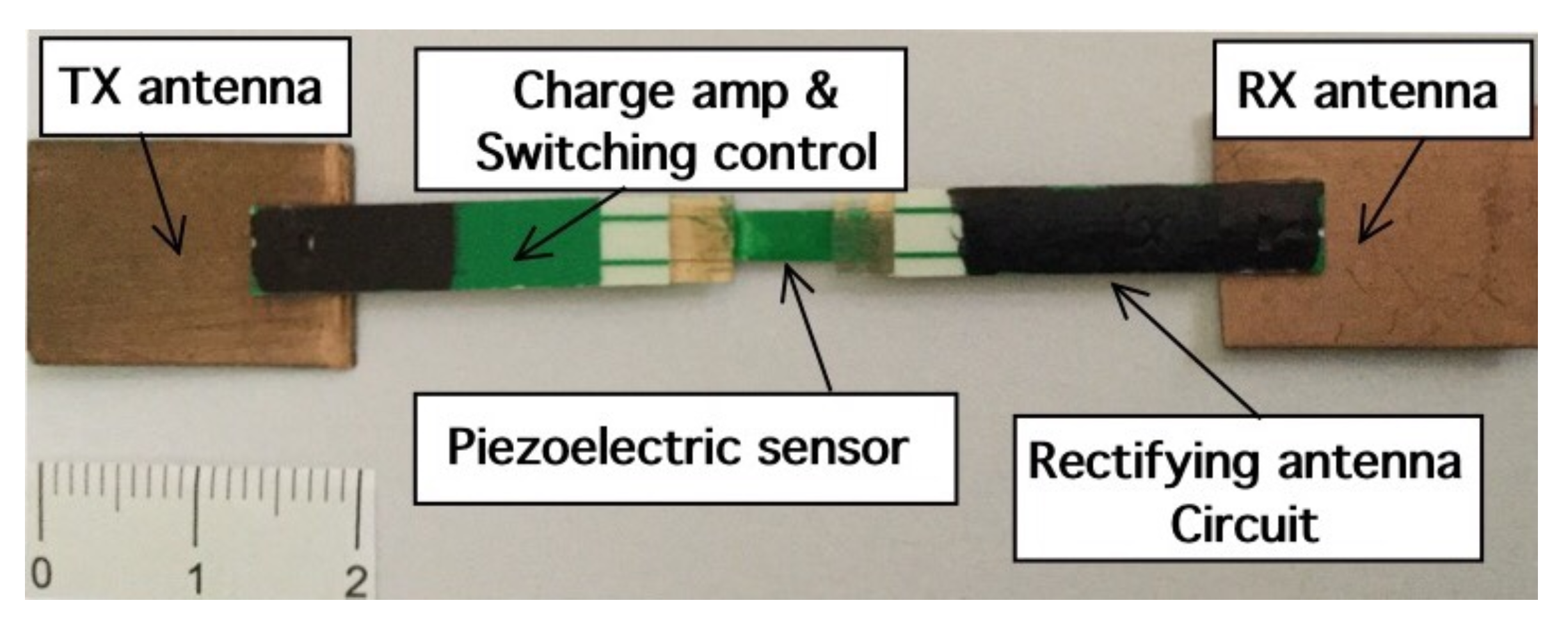
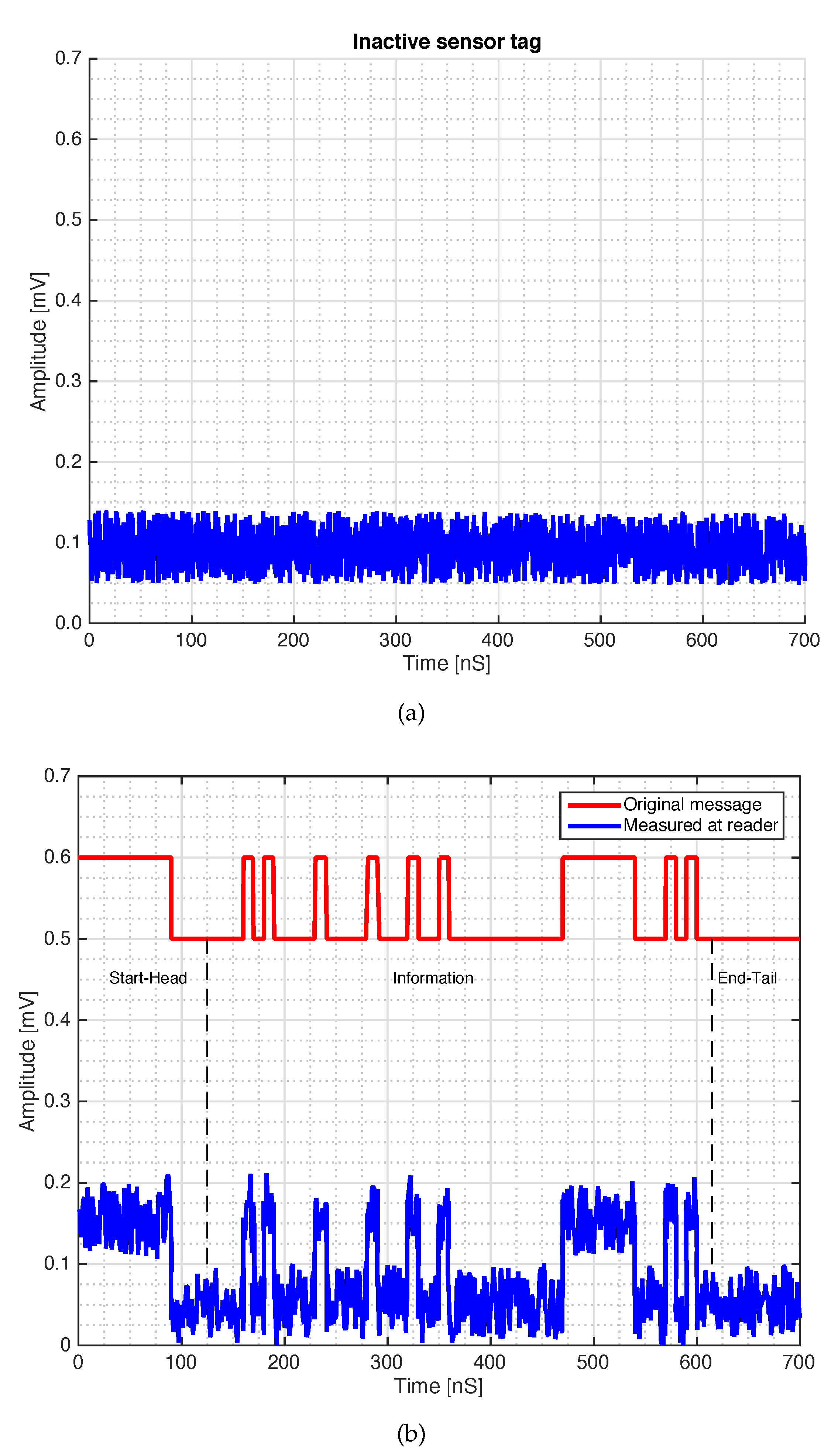

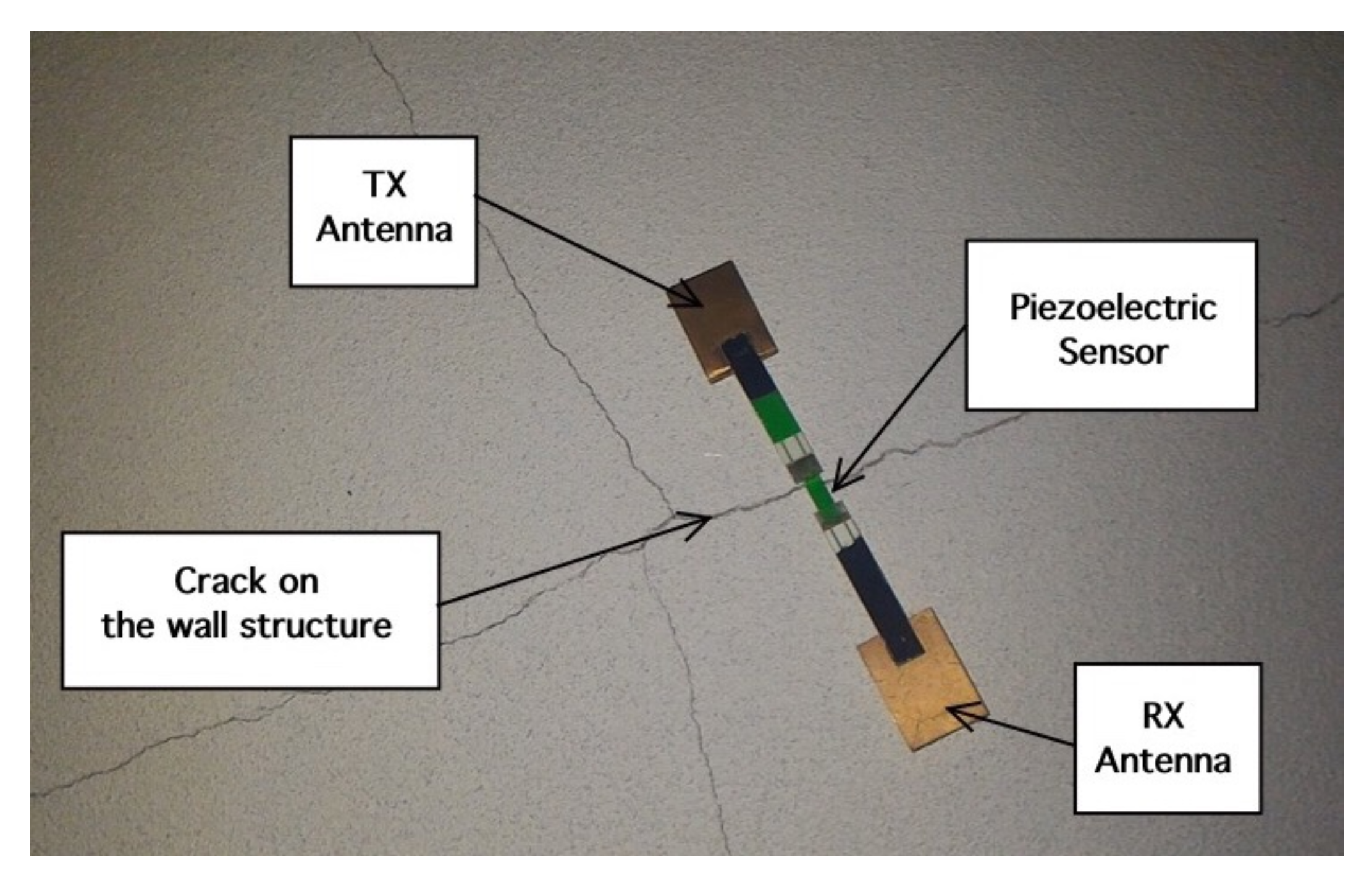
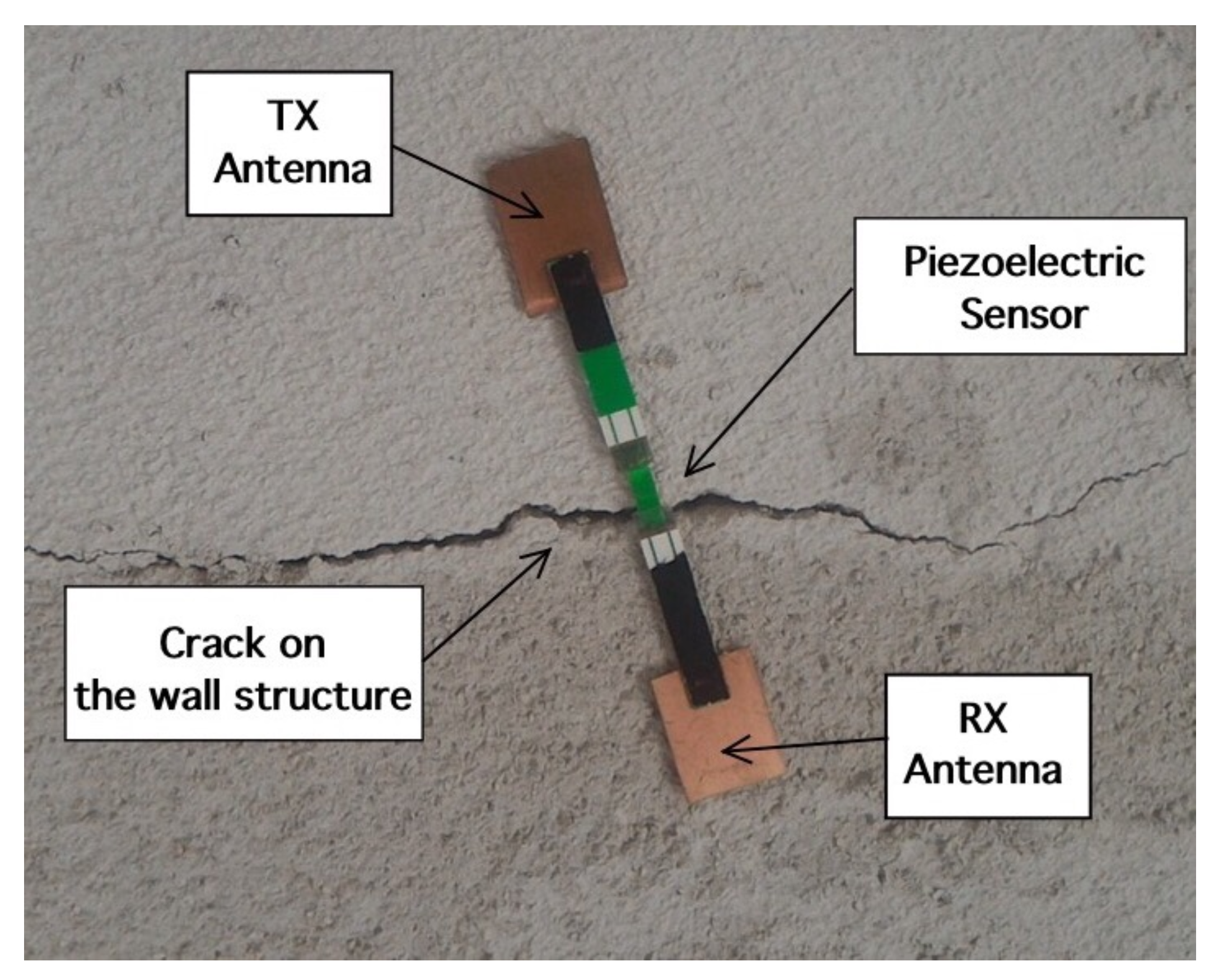


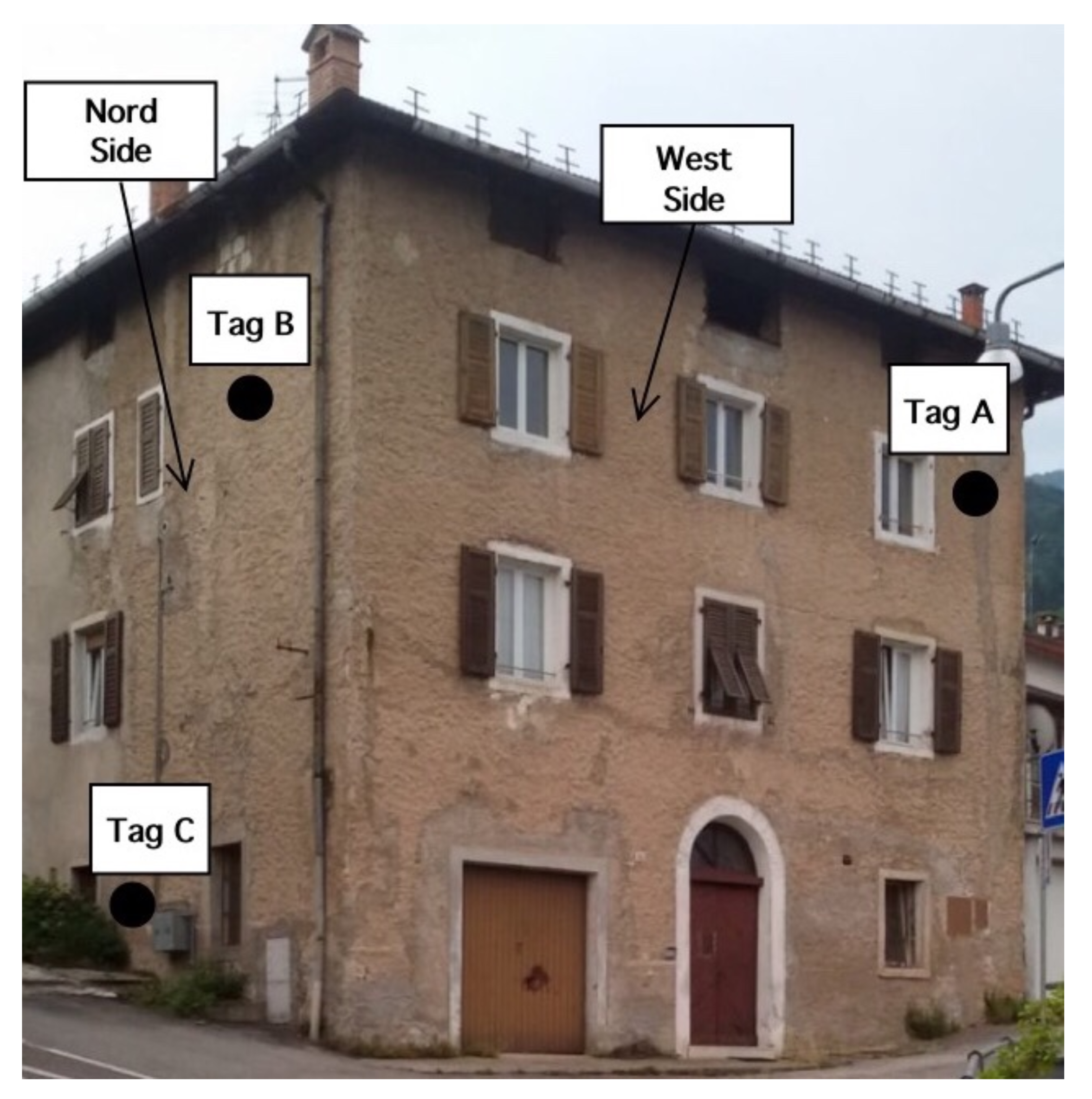
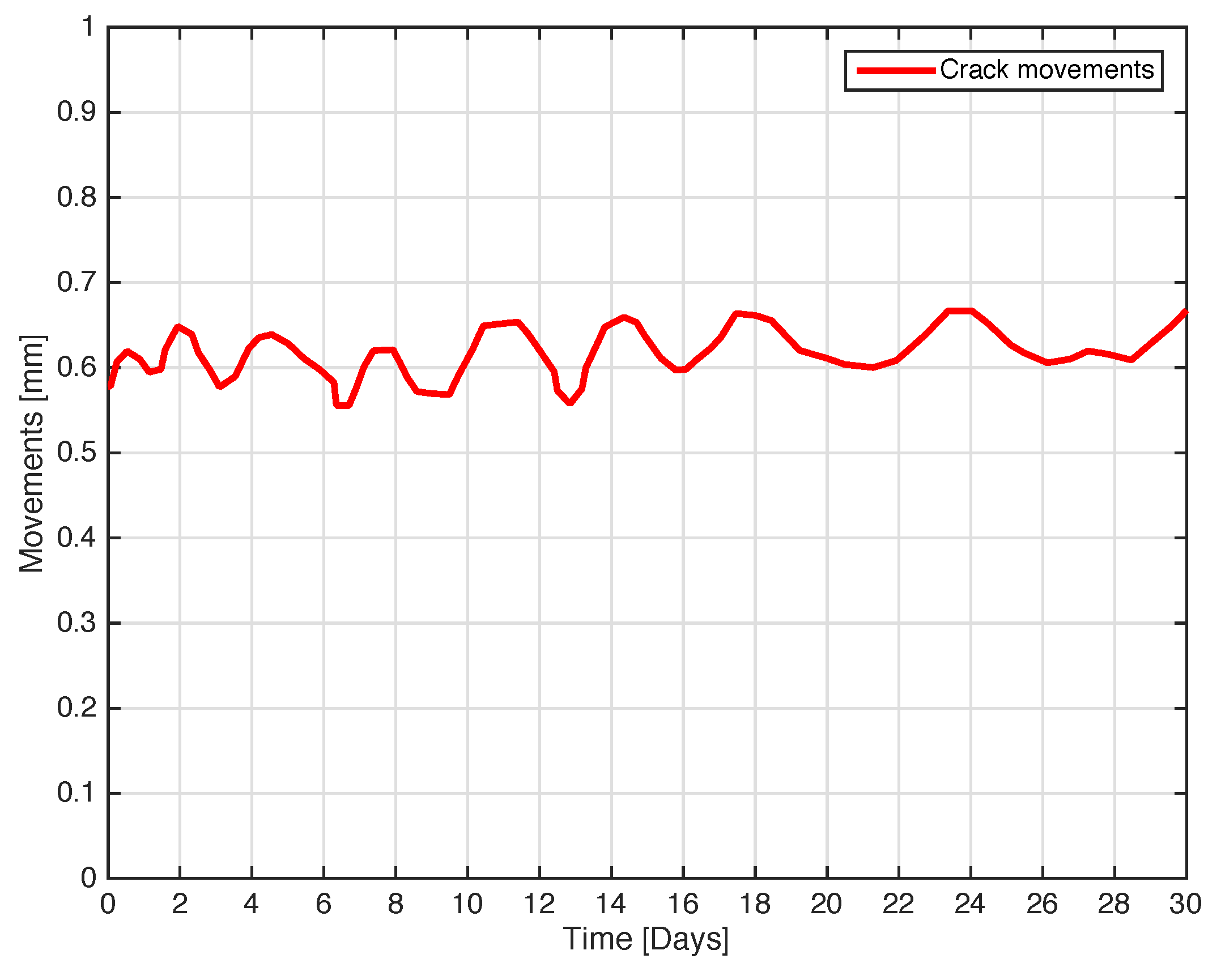
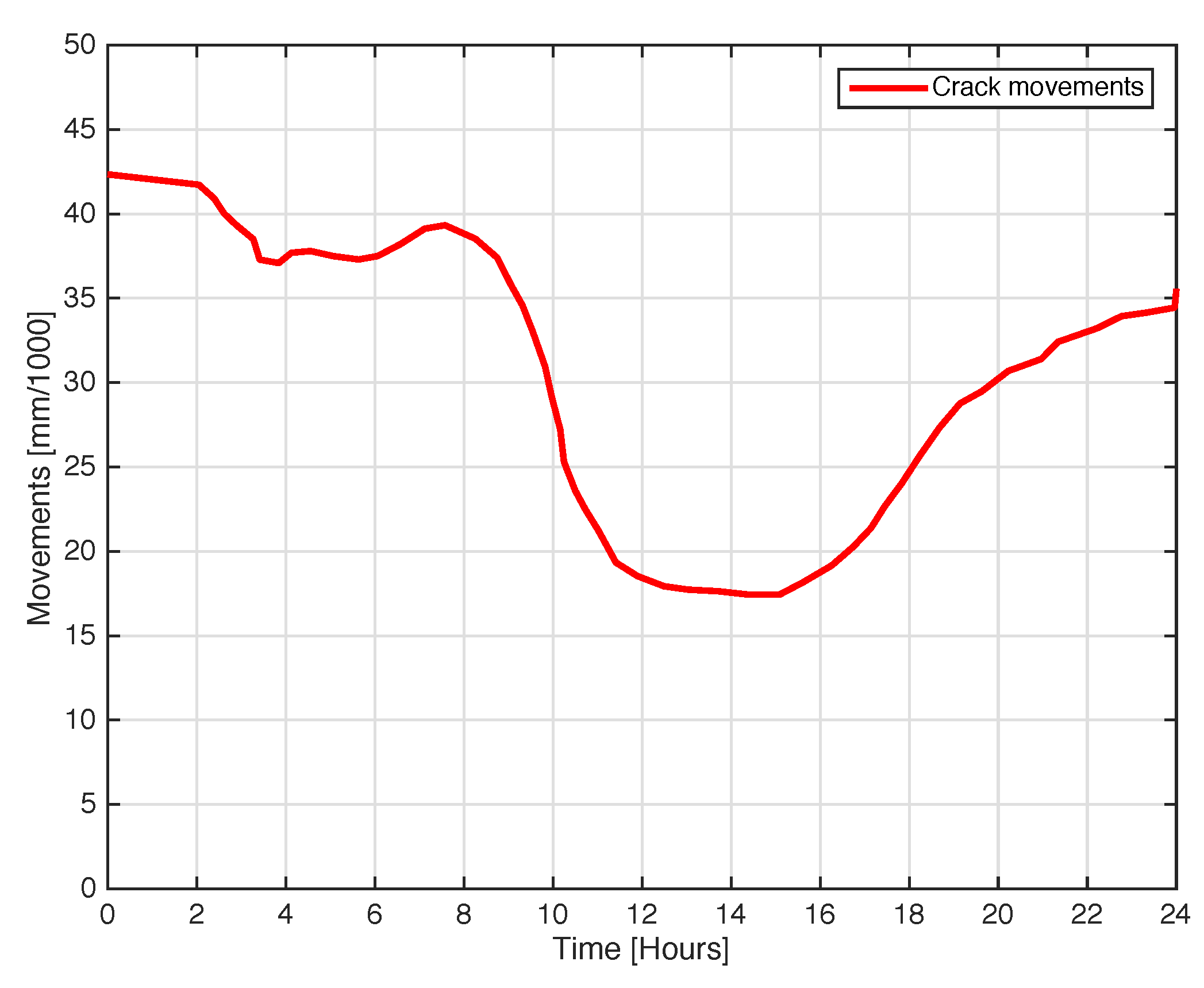

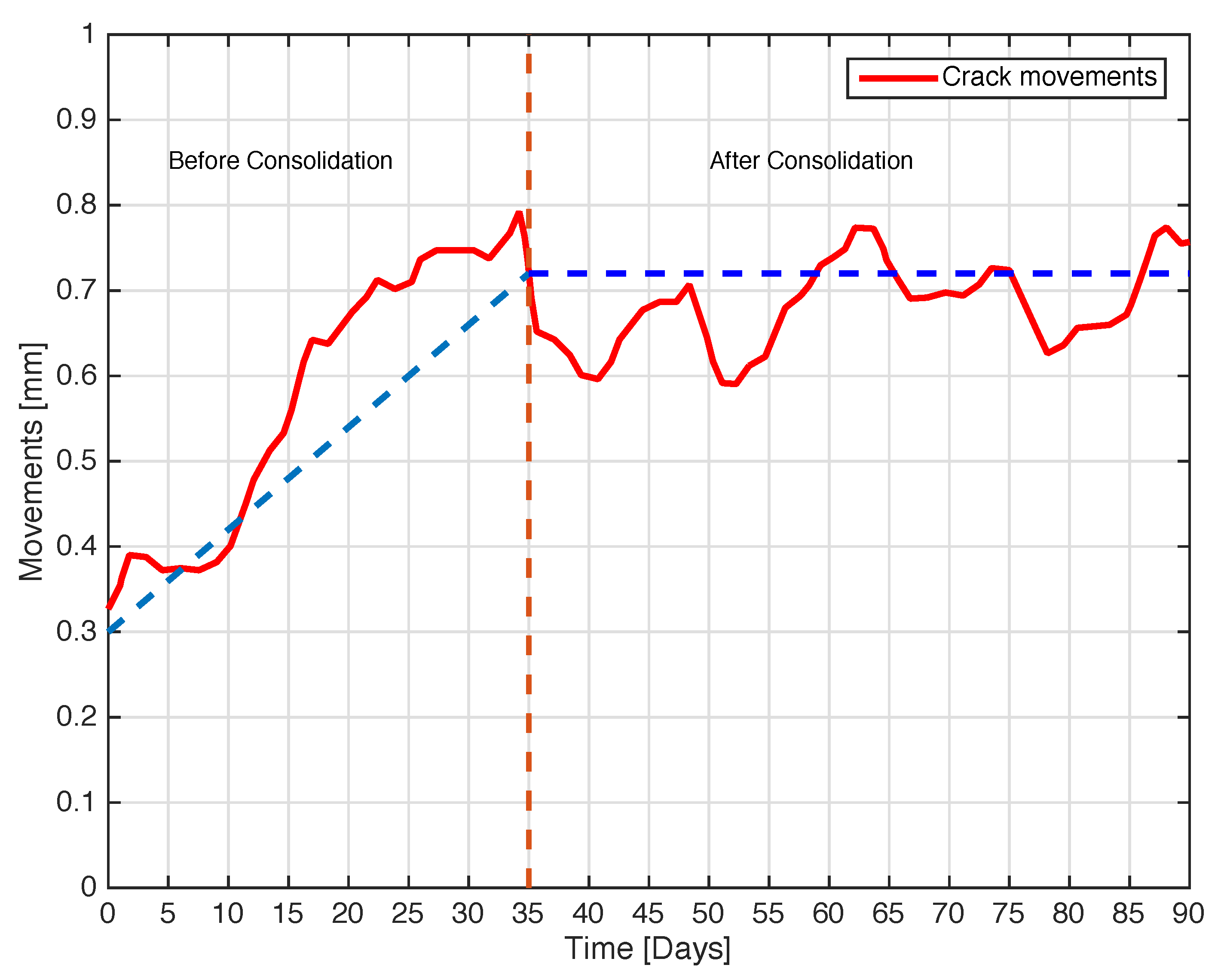

© 2018 by the author. Licensee MDPI, Basel, Switzerland. This article is an open access article distributed under the terms and conditions of the Creative Commons Attribution (CC BY) license (http://creativecommons.org/licenses/by/4.0/).
Share and Cite
Donelli, M. An RFID-Based Sensor for Masonry Crack Monitoring. Sensors 2018, 18, 4485. https://doi.org/10.3390/s18124485
Donelli M. An RFID-Based Sensor for Masonry Crack Monitoring. Sensors. 2018; 18(12):4485. https://doi.org/10.3390/s18124485
Chicago/Turabian StyleDonelli, Massimo. 2018. "An RFID-Based Sensor for Masonry Crack Monitoring" Sensors 18, no. 12: 4485. https://doi.org/10.3390/s18124485
APA StyleDonelli, M. (2018). An RFID-Based Sensor for Masonry Crack Monitoring. Sensors, 18(12), 4485. https://doi.org/10.3390/s18124485




